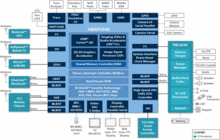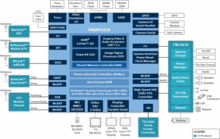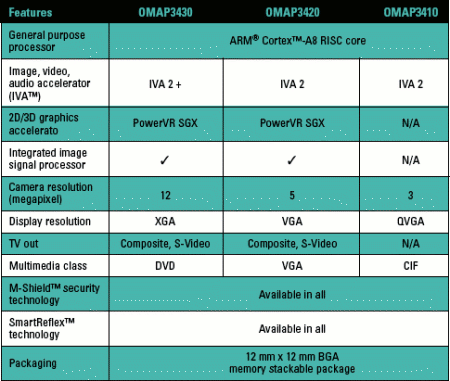Cortex-A8-based SoCs target Linux devices
Feb 11, 2008 — by LinuxDevices Staff — from the LinuxDevices Archive — 13 viewsTexas Instruments (TI) has announced the OMAP3440, its fourth mobile device system-on-chip (SoC) based on ARM's next-generation Cortex-A8 core. The company has also started sampling a development board and Linux BSP for its earlier OMAP3430 SoC, also based on the Cortex-A8 core.
The new OMAP3440 is positioned as the first SoC to support high-definition (HD) video recording and playback on 720p displays in mobile phones and mobile Internet devices (MIDs). Compared to the earlier 3430, however, it appears little changed other than in supporting a slightly different companion chip, and in supporting HD as opposed to DVD-quality video.


OMAP3440 (l) and OMAP3430 (r) function block diagram
(Click to enlarge)
The OMAP3440 is based on an 800MHz ARM Cortex-A8 core. Launched in October of 2005, the Cortex-A8 core was positioned as burning similar power to ARM11, while delivering two-to-three times better performance. TI has previously sampled two other SoCs based on the Cortex-A8, as shown in the table below.

TI OMAP3 SoC feature comparison chart
Along with the A8 core and graphics hardware claimed capable of supporting HD video, the OMAP3440 integrates a shared memory controller, several external Flash and RAM interfaces, and lots of on-chip peripheral interfaces, as shown in the diagram above. Touted benefits of the SoC include “robust” Web browsing, the ability to view HD content in full-screen mode, and to enjoy multimedia content in “any” format.
New OMAP3430 BSP and dev board
TI has introduced a “low-cost” development kit for OMAP-based smartphones and MIDs. The “Zoom Mobile Development Kit” (MDK) includes a development board built by LogicPD, along with a Linux BSP and tools. Initially available with support for the OMAP3430, it will also likely support the OMAP3440 when that part begins to sample.
Touted board features include:
- TI's OMAP-Vox cellular modem
- TI's wireless connectivity technology
- 3-megapixel camera sensor
- 3.7-inch VGA TFT touchscreen display
- TV output
On the software side, the MDK includes a Linux BSP (board support package) for the OMAP3430. However, TI supplied few details about the BSP.
Earlier, the OMAP3430 was targeted by Access for phones, and designed into an Ericsson mobile phone reference design and a portable gaming device running Linux.
Availability
The OMAP3430 is sampling now, while the OMAP3440 will sample in Q2, 2008, TI said. The Zoom MDK is also sampling in limited quantities, and will be widely available in Q2, TI said.
This article was originally published on LinuxDevices.com and has been donated to the open source community by QuinStreet Inc. Please visit LinuxToday.com for up-to-date news and articles about Linux and open source.